‘The Country of My Heart’
The book that inspired this walk…Sons & Lovers (1913)
My English teacher told me that no-one remained a DH Lawrence fan beyond their twenties and, although in a sense he was right, he was somewhat dismissing our adulation of him in our late teens. And it really never was all about the sex. In fact it was all about his power of nature description and his willingness to explore (often very chaotically) a character’s inner feelings. I still often read his poetry and travel writing today.
For me, Sons & Lovers was always his best novel by far, based as it is on real life (I never feel he was very good with plots). And the ending of the novel was probably the first time, read when I was a young teen, that I really felt a sense of place as well as fellow teenage angst: ‘But no, he would not give in. Turning sharply, he walked towards the city’s gold phosphorescence. His fists were shut, his mouth set fast. He would not take that direction, to the darkness, to follow her. He walked towards the faintly humming, glowing town, quickly.’
These attractive 1960s paperback editions, embellished with the phoenix, an important Laurentian symbol of rebirth, can still be picked up for a few pounds (a bit more than five shillings, I grant you).
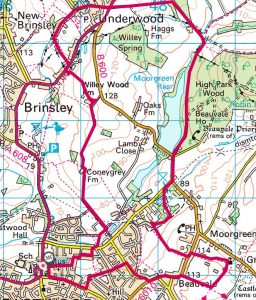
KEY DATA
- Terrain: modest hills
- Starting point: DH Lawrence Birthplace Museum, 8a Victoria St, Eastwood, NG16 3AW
- Distance: 13.4 km (8.4 miles)
- Walking time: 3 hours 41 mins
- OS Map: OS Explorer 260. This map can also be found online at: https://osmaps.ordnancesurvey.co.uk/route/9864733/Eastwood-Nottinghamshire-DH-Lawrence
- Facilities: All facilities in Eastwood
DH LAWRENCE (1885-1930)
‘I was born nearly forty-four years ago, in Eastwood, a mining village of some three thousand souls, about eight miles from Nottingham, and one mile from the small stream, the Erewash, which divides Nottinghamshire from Derbyshire. It is hilly country, looking west to Crich and towards Matlock, sixteen miles away, and east and north-east towards Mansfield and the Sherwood Forest district. To me it seemed, and still seems, an extremely beautiful countryside, just between the red sandstone and the oak-trees of Nottingham, and the cold limestone, the ash-trees, the stone fences of Derbyshire.’ (Nottingham and the Mining Country, 1929).
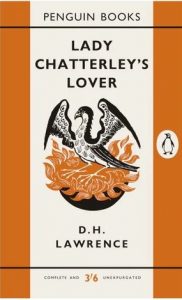 Fierce debate has raged about Lawrence’s work ever since ‘Lady Chatterley’s Lover’ was the subject of an obscenity trial in 1960, but one thing all critics agree upon is that it is his powers of observation and description, especially of the natural world, that makes him a great writer. And these are skills he started to hone as a boy wandering around the landscapes we follow in today’s route. He learnt still more when he studied Botany at Nottingham University College. Robert Gajdusek makes an interesting observation:
Fierce debate has raged about Lawrence’s work ever since ‘Lady Chatterley’s Lover’ was the subject of an obscenity trial in 1960, but one thing all critics agree upon is that it is his powers of observation and description, especially of the natural world, that makes him a great writer. And these are skills he started to hone as a boy wandering around the landscapes we follow in today’s route. He learnt still more when he studied Botany at Nottingham University College. Robert Gajdusek makes an interesting observation:
‘In the White Peacock some 145 different trees, shrubs and plants are introduced, 51 animals are brought in; 40 different birds skim, hover, flit, fly and wheel through this novel’.
But what makes Lawrence unusual as a nature writer is that he was not merely a pastoral idealist; he loved the mining landscape too (his father, of course, was a miner). As the character Paul Morel (Lawrence) says in ‘Sons & Lovers’:
‘I like the pits here and there. I like the rows of trucks, and the headstocks, and the steam in the daytime, and the lights at night. When I was a boy, I always thought a pillar of cloud by day and a pillar of fire by night was a pit.’
Lawrence concludes about his birthplace: ‘So life was a curious cross between industrialism and the old agricultural England of Shakespeare and Milton and Fielding and George Eliot.’
THE WALK
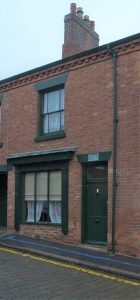 DH Lawrence’s Birthplace Museum
DH Lawrence’s Birthplace Museum
We start at DH Lawrence’s birthplace at 8a Victoria St, which is now a museum and has been converted back to show how it would have looked when Lawrence was born. Life here looked as if it would have been reasonably comfortable, if basic.
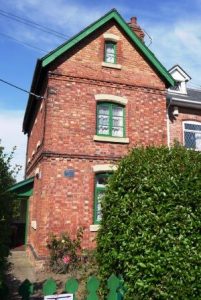 The Breach
The Breach
Next, we walk down towards the Breach, a solid-looking brick house, and Lawrence’s second home. If Lawrence’s mother was around today, she might well have appeared on the TV series ‘Location, Location, Location’ as she was always determined to move on to a bigger, more prestigious home whenever money allowed. They lived in four homes in total in Lawrence’s youth, which must have prepared him well for his nomadic life as an adult. The house we are looking at now was referred to as ‘The Bottoms’ in ‘Sons and Lovers’ (it’s now number 28 Garden Road). As an end house with extra space, this move was a step up the property ladder, with the Lawrences paying an extra six pennies a week in rent for the privilege.
‘We lived in the Breach, in a corner house. A field-path came down under a great hawthorn hedge. On the other side was the brook, with the old sheep-bridge going over into the meadows. The hawthorn hedge by the brook had grown tall as tall trees, and we used to bathe from there in the dipping-hole, where the sheep were dipped, just near the fall from the old mill-dam, where the water rushed. The mill only ceased grinding the local corn when I was a child.’
We cross the old sheep bridge over Beauvale Brook (‘Beggarlee Brook’). The hawthorn hedge still seems to be there! To our left is the cricket ground where Mrs Morel took her young son Paul.
Coneygrey (‘Herod’s Farm’)
We cross the dismantled railway line that led to Moorgreen Pit and pass Coneygrey Farm. Lawrence’s dad tramped this way each day:
‘And my father, who always worked in Brinsley pit, and who always got up at five o’clock, if not at four, would set off in the dawn across the fields at Coney Grey, and hunt for mushrooms in the long grass, or perhaps pick up a skulking rabbit, which he would bring home at evening inside the lining of his pit-coat.’
Willeywood Farm
Now amongst much undergrowth, we spy the quarry where Anable the gamekeeper dies in the White Peacock.
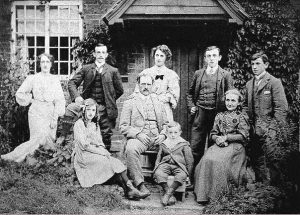
Haggs Farm (‘Willey Farm’) – private & dilapidated
‘From the hills, if you look across at Underwood wood, you’ll see a tiny red farm on the edge of the wood. That was Miriam’s farm – where I got my first incentive to write.’
The Chambers family lived at Haggs Farm from 1898 to 1910. It is difficult to overstate the importance that the farm and its inhabitants, the Chambers family, had in the development of Lawrence as a writer. Much of his early work is based in this rural environment, with the Chambers family members providing models for various characters, best known being their daughter Jessie (‘Miriam’) who is a central character in ‘Sons & Lovers’, and was Lawrence’s first love.
For Lawrence, the farm became a second home, more emotionally comforting and infinitely more supportive of literary ambition than his own. The family, though poor tenant farmers, were remarkably aware of books and literature.
‘Whatever I forget, I shall never forget the Haggs – I loved it so. I loved to come to you all, it really was a new life began in me there. The water pippin by the door – those maiden-blush roses that Flower (the horse) would lean over and eat – and Trip (the bull terrier) floundering round – and stewed figs for tea in winter, and in August green stewed apples.’ (1928 letter)
The exact route that Lawrence and Jessie took
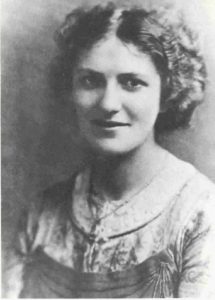 The walk across the fields from Eastwood to Haggs Farm is a walk that Lawrence and Jessie Chambers made regularly – she describes it in her book ‘DH Lawrence: A Personal Record’.
The walk across the fields from Eastwood to Haggs Farm is a walk that Lawrence and Jessie Chambers made regularly – she describes it in her book ‘DH Lawrence: A Personal Record’.
‘Then Lawrence and I would set off for my home literally burdened with books. During the walk we discussed what we had read last, but our discussion was not exactly criticism, indeed it was not criticism at all, but vivid recreation of the substance of our reading.’
It is agreeable to picture the two of them walking across the fields, arms full of books, deep in discussion about this character and that.
‘Our way led us by Moorgreen pit (now Collier’s Wood), and the quiet of the night was punctuated by the metallic rattle of the grinding engine and the rhythmic sighing of the ventilator fans…even then I had the feeling that our walks and talks through the damp, windy autumns were important, and would be memorable…I felt that I was in the presence of greatness.’
Then up Engine Lane, across the bottom of Moorgreen Reservoir, which is as far as we can trace it because the rest is on private land. Then first right through a gate (now marked private, No Right of Access) into a field path, along the western side of the reservoir, past ‘Gudruns’s creek’, following the stream up into the woods with Willey Spring Wood on the left and the ‘Warren’ (two fields of firs and spruce) on the right, to emerge with the red farm buildings straight ahead by the side of the wood.
‘And when it was time to set off on his dark two-mile walk to Eastwood, we would gather round the kitchen door and send him off with a chorus that echoed and re-echoed through the silent woods. It was a long and dark and often very muddy walk: through the farmyard, then through two fields, and down to the Warren – a plantation of dark fir trees – and on to Moorgreen Reservoir and along Engine Lane to Eastwood’.
Felley Mill
Felley Mill was one of Lawrence’s key ‘places’, having a role in three novels: as Strelley Mill in ‘The White Peacock’ and ‘Sons and Lovers’, and just as ‘The Mill’ in ‘Women in Love’, where Birkin takes lodgings.
The opening of the ‘White Peacock’ is set here: ‘I stood watching the shadowy fish slide through the gloom of the mill-pond. They were grey, descendants of the silvery things that had darted away from the monks, in the young days when the valley was lusty. The whole place was gathered in the musing of old age. The thick-piled trees on the far shore were too dark and sober to dally with the sun; the weeds stood crowded and motionless. Not even a little wind flickered the willows of the islets. The water lay softly, intensely still. Only the thin stream falling through the millrace murmured to itself of the tumult of life which had once quickened the valley.’ (Felly Priory is at the head of this stream, The Beauvale Brook)
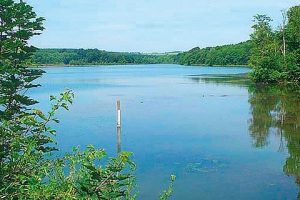 Moorgreen Reservoir (Nethermere in ‘The White Peacock’ & Willey Water in ‘Women in Love’)
Moorgreen Reservoir (Nethermere in ‘The White Peacock’ & Willey Water in ‘Women in Love’)
Jessie Chambers remembered how ‘Lawrence and I went to the little creek one holiday afternoon and saw the lake and the woods from quite a new viewpoint.’ We can spot it easily from our path on the east side of the reservoir. In ‘Women in Love’, Ursula and Gudrun row up the lake from the party and get out and swim ‘silently and blissfully’. There is a ‘knoll’ just above it, and we can imagine Gudrun rushing towards the cows here. 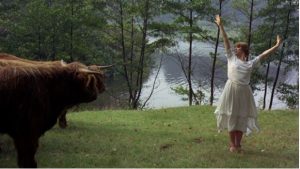
On their way home, they hear shouts, and Diana and Doctor Brindell are drowned. Ursula and Rupert go to the sluice to drain the lake, and this very sluice gate we spot as we come out at the southern end of the lake.
Beauvale Estate (‘Nethermere’)
The Gamekeeper’s hut, five minutes’ walk from the house in the woods, was the inspiration for Mellor’s hut in ‘Lady Chatterley’s Lover’, where Lady Chatterley has her amorous encounters with the gamekeeper.
‘Connie went for walks in the park, and in the woods that joined the park, and enjoyed the solitude and the mystery, kicked the brown leaves of autumn, and picked the primroses of spring.’ That pretty well describes what we are doing now…
Lamb Close Hall
Looking west up the hill on the far end of the reservoir, we spot Lamb Close Hall, the home of the Barber family, the owners of the Eastwood collieries. It was ‘Highclose’ in The White Peacock, ‘Shortland’ in ‘Women in Love’ and ‘Wragby Hall’ in Lady Chatterley’s Lover…and typically represented wealth and privilege in the novels. Lawrence described it as ‘a long low old house in brown stone, begun about the middle of the 18th century, and added on to, till it was a warren of a place without much distinction’.
Greasley (Minton in ‘Sons and Lovers’ and Greymede Church in ‘The White Peacock’)
‘Some of my happiest days I’ve spent haymaking in the fields just opposite the south side of Gresley church – bottom of Watnall Hill – adjoining the vicarage. Miriam’s father hired those fields.’ (Letters)
‘They all sat round the white spread, in the shadow of the tree and the stack, and looked out up the fields as they ate. From their shady coolness, the gold sward seemed liquid, molten with heat. The horse with the empty waggon wondered a few yards, then stood feeding. Everything was still as a trance. Now and again the horse between the shafts of the load that stood propped beside the stack jingled his loose bit as he ate.’ (‘Love amongst the Haystacks’)
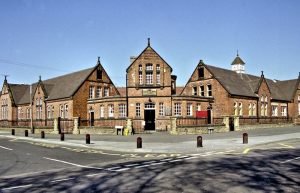 Greasley Beauvale
Greasley Beauvale
The young Lawrence attended Beauvale Board School (now renamed Greasley Beauvale D. H. Lawrence Primary School in his honour) from 1891 until 1898.
Walker St (1891-1905) ‘Scargill St’
No.10 was the Lawrence’s third family home, which Lawrence called Bleak House ‘because it stood so open to the winds’.
‘Whoever stands on Walker Street will see the whole landscape of Sons and Lovers before him: Underwood in front, the hills of Derbyshire on the left, the woods and hills of Annesley on the right. The road from Nottingham by Watnall, Moorgreen, up to Underwood and on to Annesley (Byron’s Annesley) – gives you all the landscape of The White Peacock, Miriam’s farm in Sons and Lovers, and the home of the Crich family, and Willey Water, in Women in Love.’ (Nottinghamshire and the Mining Country 1929)
Three Tuns Pub
In ‘Sons & Lovers’, the pub appears as ‘The Moon & Stars’, where Paul’s father Walter drinks. The car park in the front is where hill fairs or ‘wakes’ were held at the start of the twentieth century, also described in the novel.
We pop in for refreshments ourselves as we are nearly at the end of the walk and admire a collection of Lawrence-related photographs.
OTHER STUFF
- Read: ‘DH Lawrence: A Personal Record (1931), by Jessie Chambers
- Visit: https://www.lleisure.co.uk/d-h-lawrence-birthplace-museum/visit-us/
- Visit: The Breach House – https://thebreachhouse.co.uk/
- View: https://www.haggsfarmsociety.co.uk/
- Visit: beauvalepriory.co.uk
- Take a look at: Brinsley Headstocks Heritage Site – http://www.brinsleyheadstocks.org/site.html

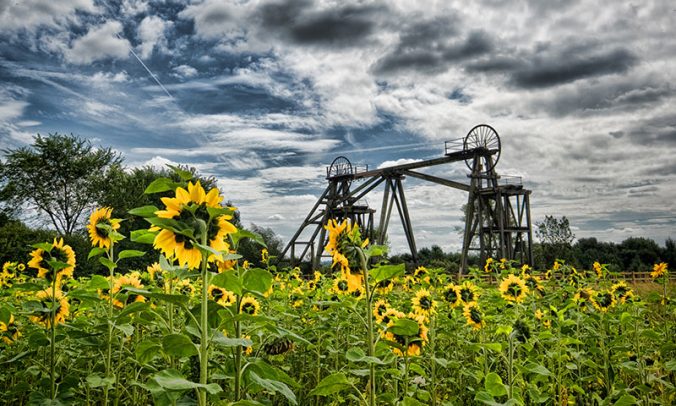
Leave a Reply